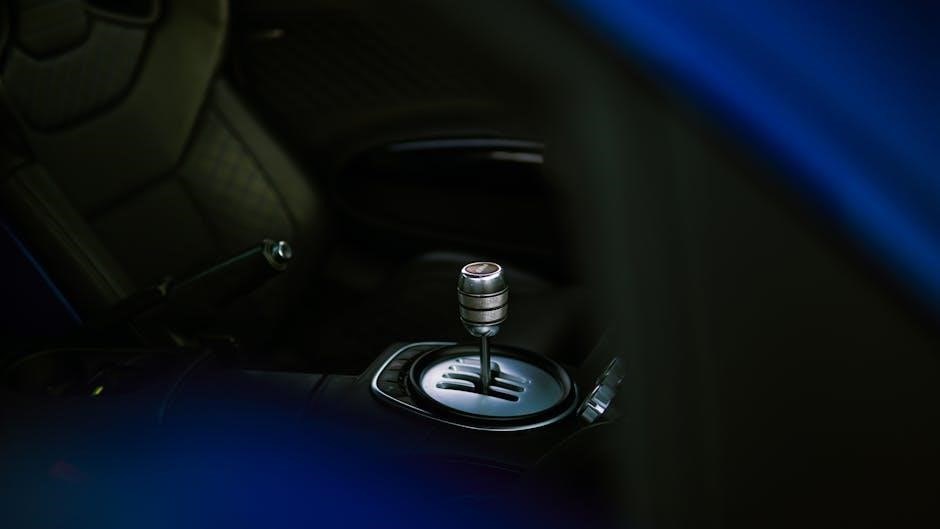A front-wheel-drive (FWD) manual transmission combines performance and efficiency‚ offering drivers precise control and engagement. Popular in hot hatches‚ these systems require skill and understanding of gear mechanics.
1.1 Definition and Overview
A front-wheel-drive (FWD) manual transmission is a drivetrain system where engine power is transmitted to the front wheels through a manual gearbox. It requires driver input to shift gears using a clutch pedal and gearshift. This setup is commonly found in compact and sporty vehicles‚ offering improved fuel efficiency and driver engagement. The manual transmission consists of a gearbox‚ clutch‚ and driveshaft‚ working in harmony to deliver power to the front wheels. Its popularity in hot hatches highlights its appeal for performance-oriented drivers seeking control and precision behind the wheel.
1.2 Importance of Manual Transmissions in FWD Vehicles
Manual transmissions in FWD vehicles are prized for their fuel efficiency‚ cost-effectiveness‚ and driver engagement. They offer better control‚ especially in city driving‚ and are often preferred by driving enthusiasts. Unlike automatics‚ manuals typically require less maintenance and are lighter‚ enhancing performance. The “money shift” technique‚ though risky‚ highlights the unique connection drivers feel with their vehicle. With innovations like Koenigsegg’s auto-manual systems‚ manuals remain relevant‚ even as automatics gain traction. For FWD hot hatches‚ a manual gearbox is often the only option‚ making these cars rare and sought after by purists.
1.3 Brief History of Manual Transmissions
Manual transmissions have evolved significantly since their inception in the early 20th century. Initially simple‚ with fewer gears‚ they became more sophisticated over time. The 1940s introduced synchromesh technology‚ reducing gear grinding and improving shifting smoothness. By the 1980s‚ manual transmissions became standard in front-wheel-drive (FWD) vehicles‚ enhancing fuel efficiency and performance. Modern systems incorporate advanced materials and computer-aided designs‚ offering better reliability and driver engagement. Despite the rise of automatics‚ manual transmissions remain popular for their tactile driving experience and efficiency‚ especially in performance-oriented FWD vehicles.
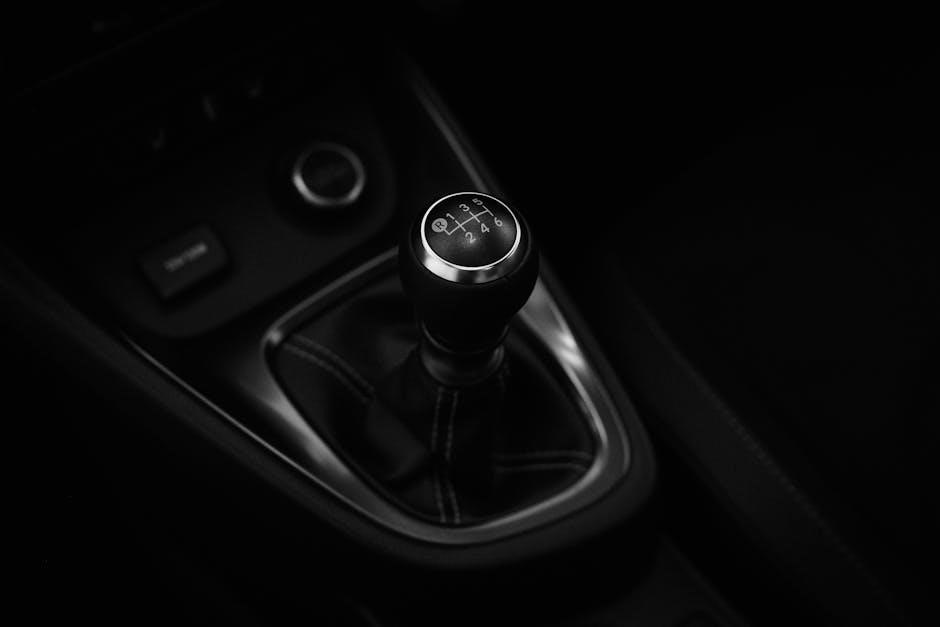
Advantages of FWD Manual Transmission
FWD manual transmissions offer improved fuel efficiency‚ lower costs‚ and a more engaging driving experience. They provide better control and connection to the vehicle‚ enhancing overall performance and satisfaction.
2.1 Improved Fuel Efficiency
FWD manual transmissions are known for their superior fuel efficiency compared to automatics. By allowing drivers to control gear shifts precisely‚ they minimize unnecessary fuel consumption. The manual system’s direct connection between engine and wheels ensures optimal power delivery‚ reducing energy loss. Proper shifting techniques‚ such as avoiding excessive RPM fluctuations‚ further enhance mileage. This efficiency makes FWD manuals a popular choice for eco-conscious drivers seeking both performance and economy.
2.2 Cost-Effectiveness
Manual transmissions in FWD vehicles are often more cost-effective than automatic or dual-clutch systems. They typically require less complex engineering‚ reducing production and purchase costs. Maintenance expenses are also lower‚ as manual transmissions have fewer components prone to failure. Additionally‚ manual transmissions generally consume less fuel‚ further saving money over time. This makes FWD manual transmissions a practical choice for budget-conscious drivers seeking reliability and efficiency without compromising performance. Their simplicity and durability contribute to long-term savings‚ making them a financially appealing option for many car buyers.
2.3 Enhanced Driving Engagement
Manual transmissions in FWD vehicles offer a unique connection between driver and car‚ fostering a more immersive driving experience. The physical act of shifting gears and using the clutch creates a sense of control and engagement‚ making every drive feel intentional and rewarding. This tactile interaction enhances driver focus and satisfaction‚ especially on winding roads or during spirited driving. The “money shift” phenomenon‚ where precise shifting avoids wear‚ further highlights the skill and engagement required. For enthusiasts‚ this hands-on approach to driving is unparalleled‚ making FWD manual transmissions a preferred choice for those who value the joy of driving over convenience.
2.4 Better Control Over the Vehicle
A manual transmission in a FWD vehicle offers superior control‚ allowing drivers to precisely manage gear shifts and torque delivery. This direct connection enhances responsiveness‚ especially during acceleration and cornering. The ability to manually select gears provides better modulation of speed and traction‚ reducing wheelspin and improving stability. In dynamic driving situations‚ such as winding roads or merging onto highways‚ the driver can maintain optimal control‚ fostering a more engaging and confident driving experience. This level of command over the vehicle is a key reason enthusiasts prefer manual transmissions‚ as it creates a deeper connection between the driver and the road.

Disadvantages of FWD Manual Transmission
Manual transmissions in FWD vehicles require complex operation‚ involving constant gear shifts and clutch use‚ which can be challenging in heavy traffic and stressful for inexperienced drivers.
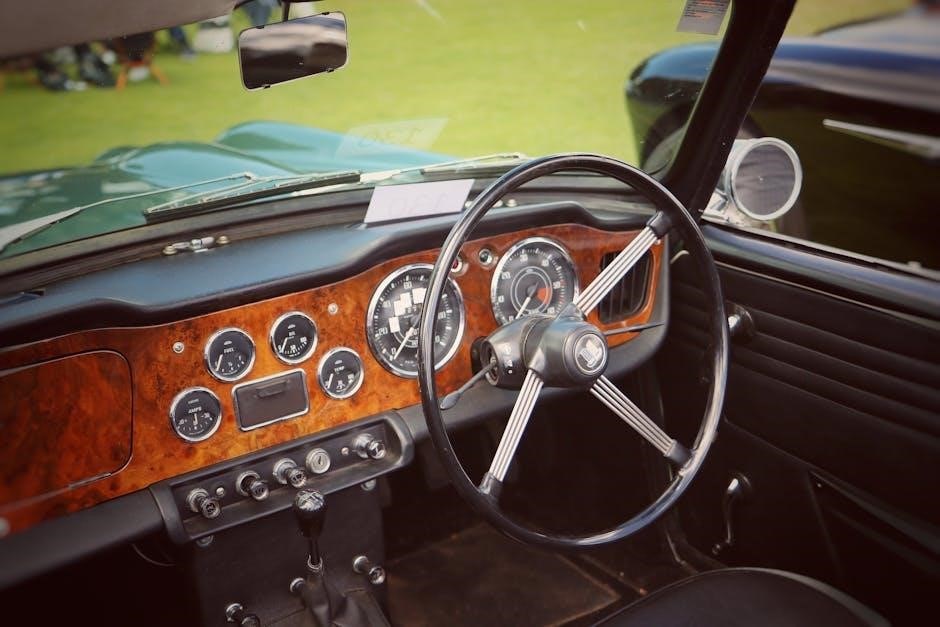
3.1 Complexity of Operation
Operating a FWD manual transmission requires coordination and skill‚ as drivers must synchronize clutch pedal engagement with gear shifts. This complexity increases in heavy traffic or hilly terrain‚ where frequent shifting is necessary. The process demands attention to engine RPMs‚ gear selection‚ and smooth transitions to avoid jerky movements. Improper techniques‚ such as “money shifts‚” can lead to wear on components like the clutch and gearbox. While modern systems offer features like rev-matching‚ the fundamental challenge remains‚ making manual transmissions less accessible to inexperienced drivers compared to automatics.
3.2 Steeper Learning Curve
Mastering a FWD manual transmission demands time and practice‚ as coordinating the clutch and accelerator requires precision. The complexity of gear shifts‚ especially in heavy traffic‚ can overwhelm newcomers. Improper techniques may lead to stalling or wear on components like the clutch. Drivers must develop muscle memory for smooth transitions and understand gear ratios for optimal performance. The learning process is more challenging compared to automatics‚ but the reward is greater control and engagement. Patience and consistent practice are essential for overcoming the initial difficulty and enjoying the benefits of manual driving.
3.3 Challenges in Heavy Traffic
Driving a FWD manual transmission in heavy traffic can be demanding due to frequent stopping and starting. Constant use of the clutch and accelerator can lead to driver fatigue. Quick gear shifts are essential to maintain momentum‚ but this requires heightened focus. In stop-and-go conditions‚ the clutch may wear faster‚ increasing maintenance needs. Additionally‚ the lack of automatic adaptation to traffic flow forces drivers to remain alert‚ making long commutes more stressful. Despite these challenges‚ many drivers appreciate the control manual transmissions provide‚ even in congested urban environments.
3.4 Increased Wear and Tear on the Clutch
The clutch in a FWD manual transmission often experiences increased wear and tear due to frequent engagement and disengagement‚ especially in stop-and-go traffic. Aggressive shifting or “riding the clutch” can accelerate wear‚ leading to premature replacement. Over time‚ the clutch disc and pressure plate may degrade‚ causing slippage or failure. Regular maintenance‚ such as adjusting the clutch pedal and avoiding unnecessary use‚ can help extend its lifespan. However‚ improper driving techniques remain a significant contributor to clutch wear‚ emphasizing the need for smooth‚ deliberate shifting to minimize stress on the system.

Key Components of a FWD Manual Transmission
The core components include the gearbox‚ clutch system‚ gearshift‚ and driveshaft‚ each playing a vital role in transmitting power and enabling smooth gear transitions in the vehicle.
4.1 Gearbox and Gears
The gearbox in a FWD manual transmission houses the gears responsible for transferring power from the engine to the wheels. It contains a set of meshing gears that adjust speed and torque. The gearbox includes both standard and reverse gears‚ with synchronizers ensuring smooth transitions between them. Modern gearboxes often feature lightweight materials like steel and advanced synthetic components for durability. The gear ratio setup is critical for performance‚ with lower gears providing more torque for acceleration and higher gears optimizing speed. Innovations like the Koenigsegg CC850’s auto-manual transmission highlight the evolution of gearbox technology.
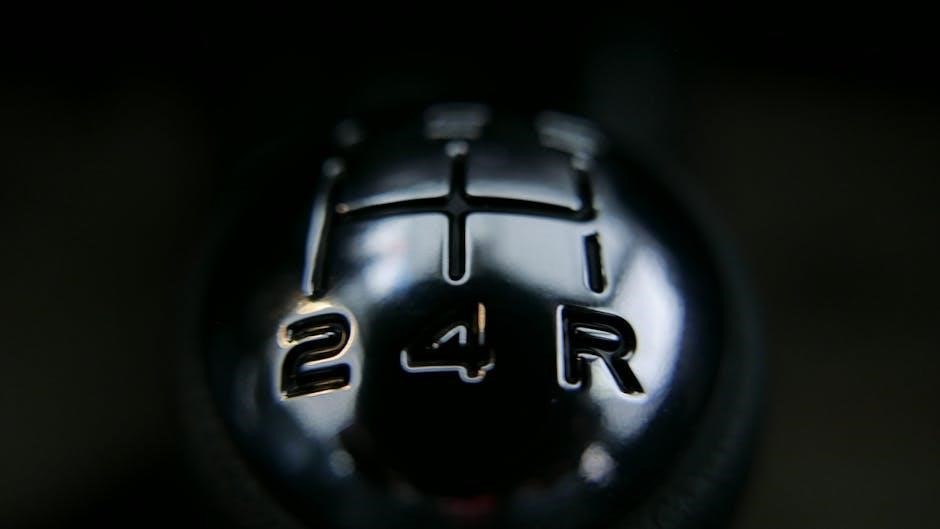
4.2 Clutch System
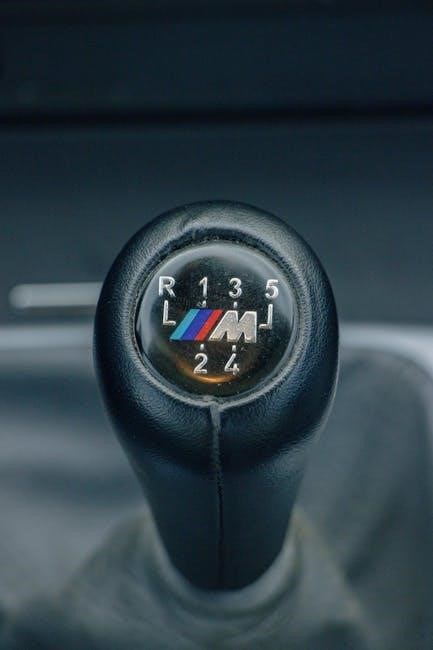
The clutch system in a FWD manual transmission is essential for disconnecting and reconnecting engine power during gear shifts. It consists of a clutch pedal‚ pressure plate‚ and friction disc. When pressed‚ the pedal disengages the engine from the gearbox‚ allowing smooth gear transitions. Proper clutch control is critical to avoid wear and tear. A “money shift” can damage the clutch and transmission if done improperly. Regular maintenance‚ such as adjusting the clutch cable or replacing worn components‚ ensures optimal performance and longevity of the system.
4.3 Gearshift and Linkage
The gearshift and linkage system in a FWD manual transmission connects the driver’s gear selection to the gearbox. The gearshift‚ typically located on the center console or floor‚ allows the driver to manually select gears. The linkage transmits this movement to the gearbox‚ engaging the desired gear. Proper alignment and adjustment of the linkage are critical for smooth‚ precise shifting. Modern systems often feature refined mechanisms to reduce wear and enhance driver feel. This component is essential for translating the driver’s input into seamless gear transitions‚ ensuring optimal performance and control. Regular maintenance is recommended to maintain its reliability and responsiveness.
4.4 Driveshaft and Differential
The driveshaft in a FWD manual transmission connects the gearbox to the differential‚ transferring power to the front wheels. The differential‚ often integrated into the transaxle‚ ensures smooth power distribution‚ allowing wheels to rotate at different speeds during turns. This setup enhances traction and stability‚ especially in cornering. The driveshaft is typically lightweight and durable‚ designed to handle torque efficiently. Proper alignment and maintenance of these components are critical for optimal performance and to prevent vibration or damage. Together‚ they play a vital role in delivering power seamlessly in FWD vehicles with manual transmissions.
How FWD Manual Transmission Works
The FWD manual transmission operates by engaging gears through a clutch and gearshift. Shifting involves pressing the clutch‚ selecting the desired gear‚ and releasing smoothly for seamless power delivery.
5.1 The Shifting Process
The shifting process in a FWD manual transmission involves coordinating clutch pedal operation with gear selection. Drivers press the clutch‚ move the gearshift into the desired gear‚ and release the clutch smoothly while accelerating; Proper timing ensures seamless power delivery and avoids jerking. The “biting point” of the clutch is critical for smooth transitions. Skilled drivers can execute quick shifts‚ enhancing performance and control. This process requires practice to master‚ especially in dynamic driving conditions. The connection between clutch and accelerator pedals is vital for maintaining momentum and stability during gear changes.

5.2 Role of the Clutch in Transmission
The clutch plays a critical role in FWD manual transmissions by connecting and disconnecting the engine from the gearbox. When pressed‚ it disengages the engine‚ allowing smooth gear shifts without grinding. Releasing the clutch slowly reconnects the engine‚ enabling power transfer to the wheels. Proper clutch control is essential for seamless acceleration and preventing wear on components. It acts as a bridge between the engine and transmission‚ ensuring efficient power delivery while maintaining driver control. Mastering clutch operation is key to optimal performance and longevity of the FWD manual transmission system.
5.3 Synchronizers and Their Function
Synchronizers are critical components in manual transmissions‚ ensuring smooth gear transitions by equalizing the speed of the gear and shaft before engagement. This prevents grinding and reduces wear. The “money shift” highlights their importance‚ as improper shifting can damage synchronizers. Modern systems‚ like the Koenigsegg CC850’s unique transmission‚ showcase advanced synchronizer technology for seamless shifting. Proper synchronization enhances driving efficiency and longevity of the transmission‚ making it a vital part of the FWD manual transmission system.
Driving Techniques for FWD Manual Transmission
Mastering smooth shifts and clutch control enhances FWD performance. Techniques include starting from a standstill‚ gradual acceleration‚ and using neutral effectively. A ‘money shift’ ensures quick gear changes without ride harshness.
6.1 Starting from a Standstill
Starting from a standstill in a FWD manual transmission requires coordination between the clutch and accelerator. Press the clutch fully‚ shift into first gear‚ and slowly release the clutch while applying gentle throttle. Avoid sudden acceleration to prevent jerking. This smooth engagement ensures control and reduces wear on the clutch. Proper technique is essential for a comfortable and efficient start‚ especially in heavy traffic or uphill situations. Mastering this skill enhances driving confidence and maintains the vehicle’s performance over time.
6.2 Smooth Shifting Between Gears
Smooth shifting in a FWD manual transmission enhances driving efficiency and control. To achieve this‚ drivers must coordinate clutch release with gear selection. Partial clutch engagement helps maintain momentum during shifts‚ reducing wear on components. Matching gear selection to speed ensures seamless transitions‚ especially in city driving. Feathering the clutch while shifting reduces jerking and improves comfort. Proper synchronization between accelerator and clutch pedals minimizes hesitation‚ making the ride smoother. Regular practice and attention to gear engagement timing are key to mastering this technique‚ which is essential for both performance and longevity of the transmission system.
6.3 Downshifting and Braking
Downshifting is a crucial technique in FWD manual transmission vehicles‚ allowing drivers to slow down smoothly and maintain control. By shifting to a lower gear before braking‚ drivers can utilize engine braking‚ reducing wear on the brakes. However‚ improper downshifting‚ such as “money shifting‚” can cause abrupt jerks and discomfort for passengers. The correct method involves pressing the clutch‚ shifting gears‚ and releasing the clutch slowly. This ensures a seamless transition and prevents mechanical stress. Downshifting is particularly effective when approaching turns or descending hills‚ as it helps maintain speed control and stability.

Maintenance and Care for FWD Manual Transmission
Regular fluid changes‚ clutch inspections‚ and gearbox checks are essential for optimal performance. Proper care extends lifespan and ensures smooth operation of the manual transmission system.
7.1 Regular Fluid Changes
Regular fluid changes are essential for maintaining the health of a FWD manual transmission. The gearbox relies on lubricating fluid to reduce friction and wear between moving components. Over time‚ the fluid can degrade‚ losing its protective properties. Neglecting fluid changes can lead to premature wear‚ increased operating temperatures‚ and potential failure of gears and bearings. It is recommended to follow the manufacturer’s schedule for fluid replacement‚ typically every 30‚000 to 60‚000 miles. Using the correct type of transmission fluid ensures optimal performance and longevity of the system. This simple maintenance step can prevent costly repairs down the road;
7.2 Clutch Replacement and Adjustment
Clutch replacement is essential when the friction material wears down‚ typically requiring removal of the transmission. Proper adjustment ensures smooth engagement and prevents premature wear. Regular inspection of the clutch pedal and hydraulic system is crucial for optimal performance. Drivers should avoid “riding the clutch” to extend its lifespan. Professional mechanics often recommend replacing the clutch cable or hydraulic components during servicing. Proper alignment of the clutch disc and pressure plate is vital to avoid vibration or noise. Regular maintenance can prevent costly repairs and ensure seamless gear transitions in FWD manual transmissions.
7.3 Inspection of Gearbox and Driveshaft
Regular inspection of the gearbox and driveshaft is crucial for maintaining the health of a FWD manual transmission. Check for signs of wear on gears‚ bearings‚ and seals. Look for fluid leaks‚ which can indicate damaged gaskets or seals. Inspect the driveshaft for any damage or misalignment‚ as this can lead to vibration and premature wear. Ensure all components are properly lubricated and functioning smoothly. Pay attention to synchronizers‚ as they are critical for smooth gear shifts. Addressing issues early prevents costly repairs and ensures optimal performance. Proper inspection helps extend the lifespan of the transmission system. Regular checks are essential for reliability.
Comparison with Other Transmission Types
FWD manual transmissions are often compared to RWD manuals‚ automatics‚ and AWD systems. Each offers unique benefits‚ with FWD manuals balancing efficiency and driver engagement effectively.
8.1 FWD Manual vs. RWD Manual
The comparison between FWD and RWD manual transmissions highlights differences in drivetrain layout and performance. FWD systems send power to the front wheels‚ improving traction and reducing weight distribution challenges. RWD‚ however‚ delivers power to the rear wheels‚ often preferred for sporty handling and balance. Both systems require precise shifting techniques‚ but FWD manuals are more common in city driving due to better low-speed maneuverability. RWD manuals‚ while less common in FWD-dominated markets‚ are favored by enthusiasts for their dynamic driving characteristics and rear-wheel dynamics. Each system caters to different driving preferences and vehicle designs.
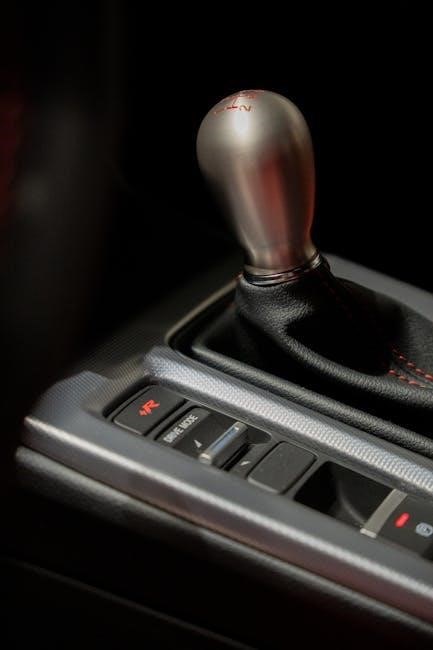
8.2 Manual vs. Automatic Transmission
Manual transmissions offer greater driver engagement and control compared to automatics‚ requiring active gear shifting. They are typically more fuel-efficient and cost less to maintain. Automatics‚ however‚ provide convenience and ease‚ especially in heavy traffic‚ as they shift gears without driver input. Manual transmissions often appeal to driving enthusiasts who value the connection to the vehicle‚ while automatics cater to those seeking comfort and simplicity. The choice between the two depends on driving habits and preferences‚ with manuals excelling in performance scenarios and automatics in urban commuting.
8.3 FWD Manual vs. AWD Manual
FWD manual transmissions send power exclusively to the front wheels‚ optimizing efficiency and reducing weight. In contrast‚ AWD manual systems distribute power to all four wheels‚ enhancing traction and control. FWD manuals are more common‚ lighter‚ and cost-effective‚ while AWD manuals‚ though less common‚ offer superior grip in adverse conditions. AWD systems are heavier and less fuel-efficient but excel in performance driving. Both systems require similar driver engagement‚ but AWD manuals provide better stability at higher speeds. The choice depends on priorities: FWD for economy and simplicity‚ AWD for enhanced capability and handling.
Future of FWD Manual Transmission
The FWD manual transmission faces evolution with hybrid and electric integrations‚ while dual-clutch systems gain traction. However‚ its popularity is declining‚ appealing mainly to driving purists.
9.1 Hybrid and Electric Integration
The integration of manual transmissions into hybrid and electric vehicles represents a significant evolution in FWD technology. By combining the efficiency of electric motors with the driver engagement of manual shifting‚ these systems aim to enhance fuel economy and reduce emissions. Advanced technologies‚ such as regenerative braking and electric assist‚ can seamlessly integrate with manual gear changes‚ creating a smoother and more efficient driving experience. For instance‚ the Koenigsegg CC850 showcases a revolutionary auto-manual transmission‚ blending traditional shifting with cutting-edge hybrid capabilities. This innovation highlights the potential for manual transmissions to remain relevant in an increasingly electrified automotive landscape.
9.2 Semi-Automatic and Dual-Clutch Systems
Semi-automatic and dual-clutch systems blend manual control with automated features‚ offering a middle ground between traditional manuals and automatics. These systems use electronic actuators to operate the clutch‚ allowing for manual gear shifts without a clutch pedal. Dual-clutch transmissions‚ like the one in the Koenigsegg CC850‚ use two clutches to pre-select gears‚ enabling faster shifts and smoother operation. These technologies maintain driver engagement while enhancing performance and efficiency‚ making them appealing for both enthusiasts and everyday drivers. They represent a modern evolution of manual transmissions‚ combining the best of both worlds.
9.3 Decline in Popularity of Manual Transmissions
The popularity of manual transmissions in FWD vehicles has declined significantly due to the rise of automatic and dual-clutch systems. Modern drivers often prioritize convenience and ease of use‚ especially in heavy traffic conditions. Additionally‚ advancements in automatic transmissions have narrowed the gap in fuel efficiency and performance compared to manuals. While enthusiasts still appreciate the control and engagement of manual transmissions‚ their market share continues to shrink as automakers focus on more accessible and technologically advanced options. This shift reflects broader trends toward automation and comfort in the automotive industry.
FWD manual transmissions offer a unique blend of performance‚ efficiency‚ and driving engagement‚ making them a niche favorite despite declining popularity in modern automotive trends.
10.1 Summary of Key Points
10;2 Final Thoughts on FWD Manual Transmission
The FWD manual transmission offers a unique driving experience‚ blending control‚ efficiency‚ and engagement. While its popularity may wane with automatics rising‚ it remains a cherished option for enthusiasts. The tactile connection between driver and vehicle fosters a deeper appreciation for the road. Innovations like the Koenigsegg CC850’s auto-manual system highlight its potential for evolution. Though challenging in heavy traffic‚ the satisfaction of mastering a “money shift” or the thrill of precise gear changes keeps it relevant. For those who enjoy driving as an art‚ the FWD manual transmission is a timeless choice‚ even as the automotive world embraces new technologies.
